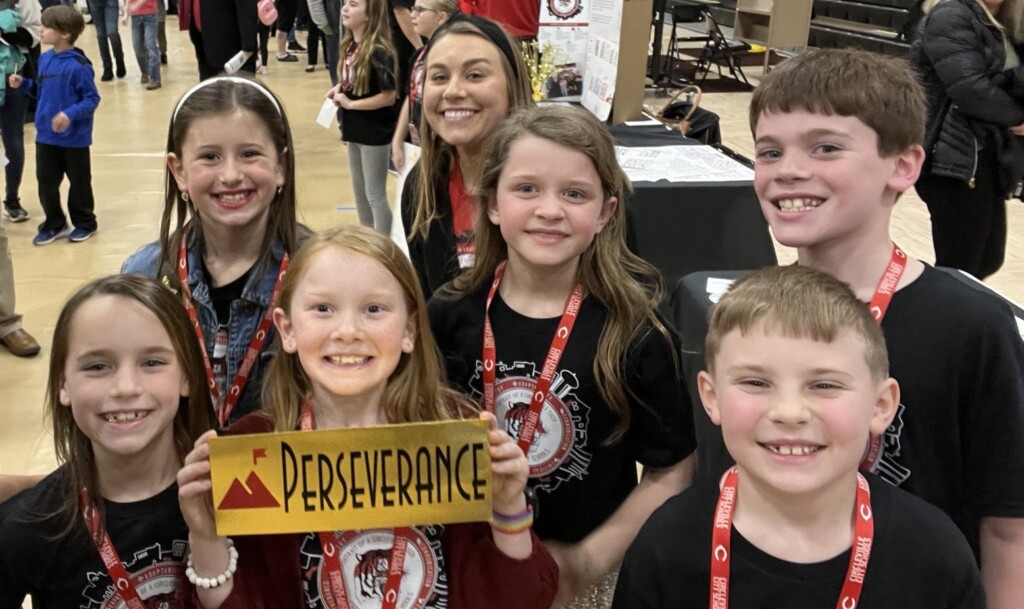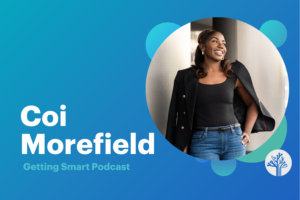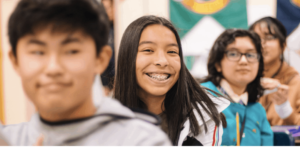How the ‘Portrait of a Graduate’ Infuses Student Learning with Joy and Hope
Key Points
-
Educational leaders can ensure students meet high learning standards while reigniting their passion for learning by broadening the focus beyond standardized testing to prioritize fostering joy and hope.
-
Giving students a say in their learning and helping them develop metacognitive and self-regulation skills increases motivation and satisfaction, leading to greater success.

By Shannon King, Ph.D.
Accountability is crucial in education. As educational leaders, we must ensure students meet high learning standards. However, our single-minded focus on standardized testing is extinguishing the joy of learning for many students. Now, imagine an education system where accountability and joy go hand in hand. As educational leaders, we have the exciting opportunity to ensure students meet high learning standards while reigniting their passion for learning. By broadening our focus beyond standardized testing to also prioritize fostering joy and hope, we can create vibrant learning environments that support students’ well-being and inspire them to thrive.
A joyless learning environment contributes to a broader issue: the well-being of students amidst a severe mental health crisis characterized by increased anxiety, depression, loneliness, and hopelessness among youth. Without joy or hope, students can become disengaged from school. These two elements—joy and hope—are essential for student success. To fully engage students, we must restore joy to learning and cultivate a sense of hope for their future.
Youth who are optimistic about their future exhibit greater resilience and a more positive outlook on life. They experience less stress, anxiety, and depression, enabling better academic focus. These students regularly attend school, engage more deeply in their studies, build stronger relationships, and develop better coping skills. They handle life’s challenges more effectively.
Drawing on psychology and neuroscience, researchers have identified key factors that can foster greater joy and hope among youth. Here are three strategies to infuse these qualities into education:
- Infuse learning with a larger purpose.
Research indicates that young people with a greater sense of purpose are happier and more satisfied than their less purposeful peers. Studies also show that a strong sense of purpose fuels hope in adults, positively impacting physical and mental health.
Students must perceive their education as having a purpose beyond achieving good grades. They need to see how the skills learned in school contribute to their future success and fulfilling careers.
- Empower students with agency.
Agency involves helping students develop their metacognitive and self-regulation skills and giving them some say in their learning; either in the topics, methods, and/or how they demonstrate understanding. Research shows that students with agency are more motivated and satisfied with their learning, leading to greater success.
- Foster social connections and a sense of belonging.
Studies have demonstrated that when students establish strong connections with their teachers and peers, they experience better mental and emotional health. They are happier and more satisfied, and they have a more positive outlook on school and life. A sense of belonging has “powerful” implications for students’ well-being and academic success, researchers have noted.
How the ‘Portrait of a Graduate’ Can Help
Over the last decade, Battelle for Kids, a national not-for-profit, has led an initiative addressing these strategies in schools, fostering greater joy and hope.
The “Portrait of a Graduate” initiative helps communities define essential skills and attributes students should acquire before graduation. Battelle for Kids and its EdLeader21 Network have supported over 135 school districts and three states in reimagining instruction using this approach, with dramatic results. Participating schools have more effectively connected teaching to workforce needs and reengaged students and teachers.
The Portrait of a Graduate creates a clear purpose for student learning beyond grades and test scores. Students are better prepared for any career path when learning focuses on developing durable skills—such as creative problem-solving, critical thinking, resilience, and empathy. This shift moves conversations away from standardized testing towards meaningful, future-ready skills.
According to America Succeeds, 85 percent of job success is attributed to developing these durable skills. Constructing high-quality learning experiences with these skills as the intended outcome restores joy to the learning process and prepares students to meet rigorous academic standards. If we teach with deeper learning in mind, the test scores will take care of themselves.
Empathy and global understanding are critical durable skills, and it’s no surprise that they should appear in most school districts’ Portraits of a Graduate. It is important to teach students how to understand a situation from someone else’s perspective and appreciate different viewpoints. This skill helps them get along with other people and work effectively with others, which is essential in our increasingly global society and workforce. It also helps students make the social connections fundamental to hope and joy.
In our extensive work with school systems, we’ve found that developing empathy among students is more achievable than previously thought. Because the Portrait of a Graduate skills are identified by each community as part of a collaborative and inclusive process, with input from parents and business leaders alike, there tends to be significant buy-in among all parties to this vision for education. Framing empathy as a durable skill that employers are looking for and that positions students for success takes much of the polarization away from these skills’ social and emotional aspects.
For students to learn these durable skills, school systems must redesign learning experiences to make them more hands-on, student-centered, and inquiry-driven. Much of the learning is project-based, with students collaborating in small groups to innovate, solve problems, and think critically about solutions to authentic local and global challenges.
In other words, educators must empower students to take charge of their own learning. This is where student agency comes in.
With its Portrait of a Graduate as the foundation, Virginia’s Frederick County Public Schools critically looked at its Teaching and Learning Framework. “Student learning experiences are being designed in a way that connects with students interests and passions,” says Assistant Superintendent for Instruction James Angelo.
The most successful districts also include students in creating their Portrait of a Graduate. A key part of the process involves engaging with students to elevate their voices and learn what they want from their education. One student who went through the process said: “I actually felt valued. I felt like the adults wanted to hear from me. I have never felt like this before.”
In California’s San Gabriel Unified School District, students have been an integral part of the process of putting the community’s vision into practice—from serving on the team that developed the Portrait’s competencies to helping create the district’s strategic plan. “The Portrait of a Graduate has been vital in shifting focus to skills, and then using the content to support their development rather than simply teaching standards. It has become our North Star for our students and our staff,” says Director of MTSS and Innovation Heather Wolpert-Gawron.
Keys to Success
In the decade-plus that we’ve been helping school districts implement the Portrait of a Graduate approach, we’ve learned many lessons that can inform the work of others. Here are three important keys to success.
- Change must happen systemwide.
The Portrait of a Graduate is a powerful way to create a united vision for education in cooperation with the community. But it doesn’t lead to transformation by itself. Instead, it’s simply a catalyst to spark transformation. Bringing this vision to life requires a systemwide effort to redesign instruction and professional development around creating authentic, inquiry-based, and student-driven learning experiences.
What’s more, the entire system must be aligned around this vision. If you think about all of the different parts of a school system, it will produce what it’s designed to produce. Leaders must re-engineer their district’s processes to support this approach. How are you hiring and evaluating teachers? What qualities are you looking for, and do these support the type of approach you’re trying to take? How are you making decisions about district priorities and choosing to use your limited resources? When you build new schools, how are you designing classrooms—and is it conducive to deeper, hands-on, student-centered learning? All these things should coalesce around the vision you’ve created with your community.
One of the things we encourage is for districts to bring a team of leaders together to engage in self-reflection. We ask them to look critically at the things they’re already doing to determine which actions bring coherence to the work and which ones are out of alignment.
- Teachers need appropriate supports.
This work will only be successful if educators feel empowered and supported. Teachers need training in how to create learning experiences that foster deeper learning and develop durable skills. They also need the time to absorb these lessons and try them out in their classrooms.
Districts that have experienced success often create tools for students, educators, and administrators to support this work, such as “I Can” statements for students to use in self-reflection and observation tools for leaders to use in their classroom walk-throughs.
Colorado’s Durango School District launched its Portrait of a Graduate initiative in 2022 to help every student find their Ikigai, the intersection of what they love to do, what they’re good at, and what the world needs. The district created a field guide to support teachers in realizing its vision.
“We’re focused on getting every kid to dream big about their future and find the thing that really drives them and is meaningful for their future,” says Board of Education President Kristen Smith.
- Create a culture where it’s okay to fail.
Systemic change is only possible when leaders and educators feel empowered to take risks in a safe and supportive environment. This work will be new to many teachers and might feel uncomfortable for them. They need to know that it’s okay to try something new and fail and that failing is a process we learn from. Trying something new, self-reflecting, and learning from the experience models the mindset we want our students to develop.
Shifting behaviors and mindsets requires shifting people’s identities or the mental models they’ve built for themselves. This is hard work. But it’s worth it in the end.
Transforming education in support of durable skills through a Portrait of a Graduate vision shifts the focus beyond test scores to include practical, real-world applications of knowledge. It fosters greater student independence and agency. It leads to deeper learning of core curriculum content. And it imbues education with meaning and joy.
We need kids to want to be in school, love learning, take joy from their education, and feel hopeful about their future. Redesigning instruction around future-ready skills is a fundamental way to meet these goals.
Together we can create a future where every student graduates not just with a diploma but with a toolkit of skills that prepares them for any challenge. A future where learning is joyful, purposeful, and filled with hope. Let’s embark on this exciting journey together. Let’s make education a source of joy and hope for every student.
Shannon King, Ph.D., is a Chief Learning Officer at Battelle for Kids. She has worked as a classroom teacher, gifted education resource teacher, instructional coach, professional development specialist, and administrator. She also works with current and aspiring educators as an Adjunct Professor at George Mason University.






Shirley A. Reynolds, Ed.D.
I am so impressed and in agreement with Dr. Shannon King's belief that our educational system needs to foster joy and hope in the experiences of all students at varying grade levels.
It was valuable learning that 85% of job success is attributed to developing the durable skills of creative problem-solving, critical thinking, resilience and empathy. Also employers look at empathy and global understanding as critical durable skills.
Shirley A. Reynolds, Ed.D.
I am in agreement with Dr. Shannon King's statement of broadening the focus beyond standardized testing to prioritize fostering joy and hope in all students' educational experiences.
Learning that 85% of job success is attributed to developing the durable skills of creative problem-solving, critical thinking, resilience and empathy is great enough reason for me as an educator to work extremely hard to bring forth a dynamic PCBL foundation for my kindergarteners.